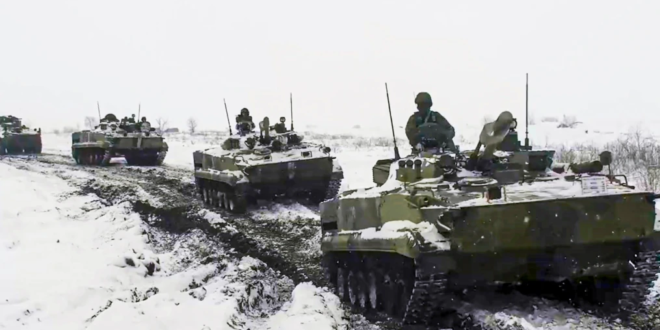Russia has said that it received “no positive response” from the United States over its main security concerns in a standoff over Ukraine, though room exists to continue dialogue over several issues.
As expected, the United States and NATO on January 26 rejected Moscow’s demand to permanently shut the door on Ukraine ever joining the alliance and said allied deployments of troops and military equipment in Eastern Europe are nonnegotiable.
However, in a letter to Moscow the United States laid out what it called “a serious diplomatic path” to resolve the Ukraine crisis, while repeating threats of unprecedented economic sanctions should Russian further invade Ukraine.
The focus is now on how President Vladimir Putin will respond to the U.S. offer for more diplomacy at a time Russia’s military continues to build up its capabilities near Ukraine and in its ally, Belarus, creating growing concern of a possible attack. Russia denies it is planning to attack.
Several rounds of diplomacy in European capitals this month between the West and Moscow failed to reach a breakthrough, although the sides have shown a willingness to continue talks.
U.S. Secretary of State Antony Blinken said the West was committed to maintaining NATO’s “open-door” policy while offering a “principled and pragmatic” evaluation of the concerns that Moscow has raised.
Kremlin spokesman Dmitry Peskov told reporters on January 27 that the U.S. response showed no “willingness” to accommodate Russia’s concerns and left “little ground for optimism.”
But he added that “there always are prospects for continuing a dialogue, it’s in the interests of both us and the Americans.”
In separate comments, Foreign Minister Sergei Lavrov said Russia’s main demand — that Ukraine will not join NATO — had been ignored, but that it would be possible to move forward on other issues.
“There was no positive response to the main question,” Lavrov said in a statement, but “there is a response which gives hope for the start of a serious conversation on secondary questions.”
Although the contents of the U.S. letter were not made public, Lavrov was possibly referring to previous U.S. suggestions that the sides engage on issues such as arms control, confidence-building measures, and limits on the size and scope of military exercises.
Meanwhile, U.S. President Joe Biden held a phone call with his Ukrainian counterpart, Volodymyr Zelenskiy, to again reaffirm the readiness of the United States along with its allies to “respond decisively” if Russia further invades Ukraine.
Biden also told Zelenskiy the United States is exploring additional macroeconomic support to help Ukraine’s financial situation, which has been battered by concerns over an outbreak of war, the White House said.
“Had a long phone conversation with POTUS,” Zelenskiy tweeted. “Discussed recent diplomatic efforts on de-escalation and agreed on joint actions for the future. Thanked President Joe Biden for the ongoing military assistance. Possibilities for financial support to Ukraine were also discussed.”
In another development, the United States has called for a public meeting of the UN Security Council on January 31 to discuss Russia’s military buildup as “a matter of crucial importance to international peace and security.”
“More than 100,000 Russian troops are deployed on the Ukrainian border and Russia is engaging in other destabilizing acts aimed at Ukraine, posing a clear threat to international peace and security and the UN Charter,” U.S. Ambassador to the UN, Linda Thomas-Greenfield, said in a statement on January 27.
Moscow’s reaction to the U.S. letter came as Ukrainian Foreign Minister Dmytro Kuleba said the number of Russian troops near the border with Ukraine continues to grow.
Russia has amassed more than 100,000 troops, according to Western intelligence, near the border with Ukraine and has been holding a series of land and sea military exercises. Last week Ukrainian intelligence officials put the number at 127,000.
NATO this week said it was bolstering its deterrence in the Baltic Sea and Eastern European region, and the U.S. ordered 8,500 troops on high alert for potential deployment to Europe to reassure NATO allies on the eastern flank.
Meanwhile, the United States and several of its NATO allies have been sending military supplies and weaponry to Ukraine, including anti-tank missiles, to help Kyiv blunt any Russian incursion.
Moscow has been backing separatist fighters in an ongoing war in eastern Ukraine that has claimed more than 13,200 lives since 2014, the same year Russian illegally annexed Crimea.
After meeting in Paris on January 27, advisers to the leaders of Russia, Ukraine, France, and Germany reaffirmed in a joint statement their commitment to uphold a cease-fire agreed in the Minsk accords aimed at putting an end to the conflict in the east.
Although there was no breakthrough in the talks, held under the so-called Normandy format, the countries promised to meet for new talks in two weeks in Berlin.
Kuleba said it was a sign Russia is likely to remain on a diplomatic path at least for the short term.
“The good news is that advisers agreed to meet in Berlin in two weeks, which means that Russia for the next two weeks is likely to remain on the diplomatic track,” he said following a meeting with his Danish counterpart Jeppe Kofod.
French President Emmanuel Macron is expected to hold a phone call with Putin on January 28 in which he is expected to seek clarification over Russia’s intentions.
 Eurasia Press & News
Eurasia Press & News



